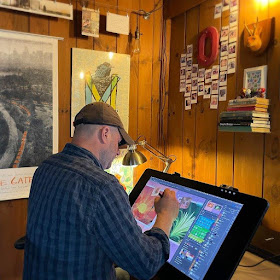I’ve learned a lot over the past five years while focusing solely on illustrating picture books. I still feel like a “newbie” when I open a manuscript, tasked with adding my art to someone’s hard earned text: Where do I start? How do I get ideas? What does that thing or character look like? Am I really getting paid to illustrate poop?
Every book is different, but there are some common threads. No matter the style in which an illustrator works or freedom afforded by the art director, the story is set someplace with rules that apply to that world. The closer the world sits to reality, the more research an illustrator must do into that world. We owe that to our young audience. It’s important that we do our illustrator homework.
In the past two years I’ve had the opportunity to illustrate two books in a series that straddle the fiction/non-fiction line. The books are about real things in nature (the stuff of non-fiction) presented by a talking bug narrator (the stuff of fiction). In the books Butterflies Are Pretty… Gross! and it’s sibling Flowers Are Pretty… Weird! (written by Rosemary Mosco, published by Tundra Books), I knew that the easy part would be the narrator. I’m good at characters and have exercised the creative fiction side of my career my whole life. A spunky bumble bee waxing on about flowers tumbled out of my imagination rather easily.
What I didn’t know was what an Alcon Blue Butterfly caterpillar looked like or why a particular orchid was named “Monkey Orchid.”
It might seem obvious (and it is!) but a folder full of research and visual material is an absolute must for getting these details right. I’ve collected reference material several different ways, but always begin by using search engines to find images. I store them either in a hidden Pinterest collection or a folder on my hard drive, labeled carefully (important for recall). There are times when I’ll need to reach back out to the art director or editor about a specific detail. I also find myself reading papers or articles when the photo reference doesn’t give me enough to work with.
Details matter! I’ve been asked about the colorings of certain butterflies by feisty second graders. Parents reading these books to their kids might be experts in the field and will be great ambassadors for a book that gets the details right.
I’ve just wrapped up the art for a book called Max And Ed Bike To Nome (by Matthew Lasley, releasing April 4, 2023 by West Margin Press). It’s based on the real-life bike ride of Ed Jesson during the Klondike Gold Rush in Alaska. I was super thankful to find photographic reference material from the 1890s! The State of Alaska has an amazing collection of old photos to dig through. The final art is built upon the visual information I was able to comb.
Lastly, reference is the greatest starting point for creativity. I’ve found that this is where the fun and magic of illustrating resides. A good base level of visual information is a great foundation to jump off and get creative with. As famous jazz improviser Charles Mingus said “You can’t improvise on nothing, man; you’ve gotta improvise on something.”
Jacob Souva is an illustrator/author of picture books. You can find out more about him and his books at his website, www.twofishillustration.com. I met him a few years ago, and reviewed his fun book about panning for gold, Pedro's Pan.



No comments:
Post a Comment